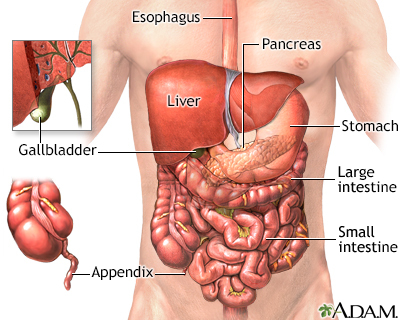Abdominal sounds
Definition
Abdominal sounds are the noises made by the intestines.
Alternative Names
Bowel sounds
Considerations
Abdominal sounds (bowel sounds) are made by the movement of the intestines as they push food through. The intestines are hollow, so bowel sounds echo through the abdomen much like the sounds heard from water pipes.
Most bowel sounds are normal. They simply mean that the gastrointestinal tract is working. A health care provider can check abdominal sounds by listening to the abdomen with a stethoscope (auscultation).
Most bowel sounds are harmless. However, there are some cases in which abnormal sounds can indicate a problem.
Patient Education Video: Digestion
Ileus is a condition in which there is a lack of intestinal activity. Many medical conditions may lead to ileus. This problem can cause gas, fluids, and the contents of the intestines to build up and break open (rupture) the bowel wall. The provider may be unable to hear any bowel sounds when listening to the abdomen.
Reduced (hypoactive) bowel sounds include a reduction in the loudness, tone, or regularity of the sounds. They are a sign that intestinal activity has slowed.
Hypoactive bowel sounds are normal during sleep. They also occur normally for a short time after the use of certain medicines and after abdominal surgery. Decreased or absent bowel sounds often indicate constipation.
Increased (hyperactive) bowel sounds can sometimes be heard even without a stethoscope. Hyperactive bowel sounds mean there is an increase in intestinal activity. This may happen with diarrhea or after eating.
Abdominal sounds are always evaluated together with symptoms such as:
- Gas
- Nausea
- Presence or absence of bowel movements
- Vomiting
If bowel sounds are hypoactive or hyperactive and there are other abnormal symptoms, you should continue to follow-up with your provider.
For example, no bowel sounds after a period of hyperactive bowel sounds can mean there is a rupture of the intestines, or strangulation of the bowel and death (necrosis) of the bowel tissue.
Very high-pitched bowel sounds may be a sign of early bowel obstruction.
Causes
Most of the sounds you hear in your stomach and intestines are due to normal digestion. They are not a cause for concern. Many conditions can cause hyperactive or hypoactive bowel sounds. Most are harmless and do not need to be treated.
The following is a list of more serious conditions that can cause abnormal bowel sounds.
Hyperactive, hypoactive, or missing bowel sounds may be caused by:
- Blocked blood vessels prevent the intestines from getting proper blood flow. For example, blood clots can cause mesenteric artery occlusion.
- Mechanical bowel obstruction is caused by hernia, tumor, adhesions, or similar conditions that can block the intestines.
- Paralytic ileus is a problem with the nerves to the intestines.
Other causes of hypoactive bowel sounds include:
- Drugs that slow down movement in the intestines such as opiates (including codeine), anticholinergics, and phenothiazines
- General anesthesia
- Radiation to the abdomen
- Spinal anesthesia
- Surgery in the abdomen
Other causes of hyperactive bowel sounds include:
When to Contact a Medical Professional
Call your provider if you have any symptoms such as:
- Bleeding from your rectum
- Nausea
- Diarrhea or constipation that continues
- Vomiting
What to Expect at Your Office Visit
The provider will examine you and ask you questions about your medical history and symptoms. You may be asked:
- What other symptoms do you have?
- Do you have abdominal pain?
- Do you have diarrhea or constipation?
- Do you have abdominal distention?
- Do you have excessive or absent gas (flatus)?
- Have you noticed any bleeding from the rectum or black stools?
You may need the following tests:
- Abdominal CT scan
- Abdominal x-ray
- Blood tests
- Endoscopy
If there are signs of an emergency, you will be sent to the hospital. A tube will be placed through your nose or mouth into the stomach or intestines. This empties your intestines. In most cases, you will not be allowed to eat or drink anything so your intestines can rest. You will be given fluids through a vein (intravenously).
You may be given medicine to reduce symptoms and to treat the cause of the problem. The type of medicine will depend on the cause of the problem. Some people may need surgery right away.
Gallery

References
Ball JW, Dains JE, Flynn JA, Solomon BS, Stewart RW. Abdomen. In: Ball JW, Dains JE, Flynn JA, Solomon BS, Stewart RW, eds. Seidel's Guide to Physical Examination. 9th ed. St Louis, MO: Elsevier; 2019:chap 18.
Landmann A, Bonds M, Postier R. Acute abdomen. In: Townsend CM Jr, Beauchamp RD, Evers BM, Mattox KL, eds. Sabiston Textbook of Surgery. 21st ed. St Louis, MO: Elsevier; 2022:chap 46.
McQuaid KR. Approach to the patient with gastrointestinal disease. In: Goldman L, Schafer AI, eds. Goldman-Cecil Medicine. 26th ed. Philadelphia, PA: Elsevier; 2020:chap 123.